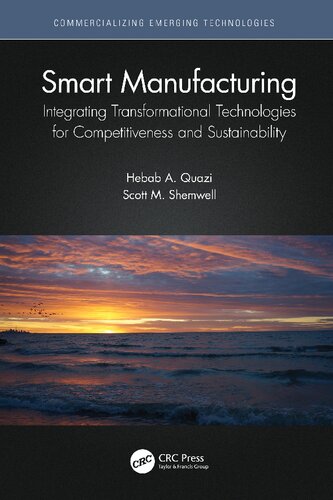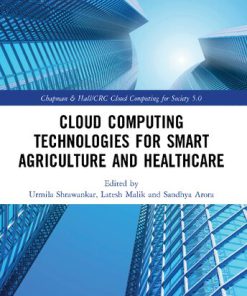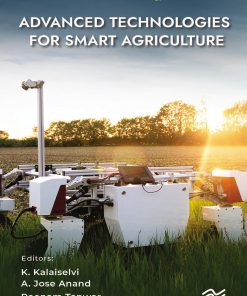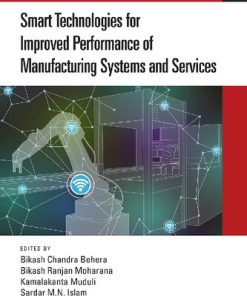Smart Manufacturing Integrating Transformational Technologies for Competitiveness and Sustainability 1st Edition by Scott Shemwell, Hebab Quazi 0367742926 9780367742928
$50.00 Original price was: $50.00.$25.00Current price is: $25.00.
Smart Manufacturing Integrating Transformational Technologies for Competitiveness and Sustainability 1st Edition by Scott Shemwell, Hebab Quazi – Ebook PDF Instant Download/Delivery: 0367742926, 9780367742928
Full download Smart Manufacturing Integrating Transformational Technologies for Competitiveness and Sustainability 1st Edition after payment

Product details:
ISBN 10: 0367742926
ISBN 13: 9780367742928
Author: Hebab A. Quazi; Scott M. Shemwell
The manufacturing industries remain the foundation of local, regional, and global economies. Manufacturing plants operate in dynamic markets that demand upgrading with transformational technologies for maintaining profitability, competitiveness, and business sustainability. Yet most manufacturing plants currently use technologies that are no longer competitive, and industry leaders face an overwhelming array of operational challenges that require agile and enhanced transformational solutions. This book offers manufacturers effective strategies and tools for the adoption and implementation of advanced operational technologies to ensure long-term innovation, efficiency, and profitability. Covers advanced automation integration in manufacturing, including digitization, AI, machine learning, IIoT, and cybersecurity Describes innovation, development, and integration of control technologies for sustainable manufacturing Explains how to upgrade existing manufacturing plants for the global market Shows how to apply emerging technologies including asset optimization and process integration for product lifecycle improvements, plant operation and maintenance enhancement, and supply chain integration This book serves as a strategic guide to applying advanced operational technologies for engineers, industry professionals, and management in the manufacturing sector.
Smart Manufacturing Integrating Transformational Technologies for Competitiveness and Sustainability 1st Table of contents:
Chapter 1 Smart Manufacturing
1.1 Introduction
1.1.1 Productivity
1.1.2 Digitization
1.1.3 IT/OT/IIoT
1.1.4 Cybersecurity
1.1.5 Operational Strategy
1.2 Challenges and Opportunities
1.2.1 Identifying Challenges
1.2.2 Targeting Opportunities
1.3 Smart Manufacturing Techniques
1.3.1 Transformational Technologies
1.3.2 Prototyping
1.3.3 Transformational-Technology Commercialization
1.3.4 Intellectual Property Protection
1.3.5 Risk Management
1.4 Competitiveness and Sustainability
1.4.1 Planning
1.4.2 Financing
1.4.3 Competitiveness
1.4.4 Sustainability
1.4.5 Customer Alliance
1.5 Market Trends and Broader Opportunities
1.5.1 Artificial Intelligence/Machine Learning
1.5.2 Digital Transformation
1.5.3 Innovative Infrastructures
1.5.4 Global Warming
1.5.5 Smart Cities
1.5.6 Emerging Markets
Chapter 2 Operational Technologies
2.1 Introduction
2.1.1 One Caveat
2.1.2 Key Implementation Action Items
2.1.3 Managing Complexity
2.1.4 Rapid Response Management
2.1.5 Guide to This Section
2.2 Information Technology Operational Technology
2.2.1 Human vs. Machine
2.2.2 Human Factors Engineering
2.2.3 Human Systems Integration
2.2.4 High Reliability Management
2.3 Value Proposition
2.3.1 Expected Value of Marginal Information
2.3.2 Maximizing Capital Efficiency
2.3.3 Conclusion
2.4 Environmental, Social, and Governance
2.5 Maturity Models
2.5.1 Smart Manufacturing Maturity
2.5.2 Software and Data
2.5.3 Digitalization
2.5.4 Process
2.5.5 Governance
2.5.6 Conclusion
2.6 Technology Take-Up
2.6.1 Adoption Model
2.6.2 Gartner
2.6.3 Magic Quadrant
2.6.3.1 Hype-Cycle
2.7 Reference Architecture
2.7.1 Conclusion
2.8 Process Integration and Optimization
2.8.1 Processes and Methods
2.8.2 Enabling Tools
2.8.3 Strong Bond Governance
2.8.4 Data Lessons from Covid-19
2.8.5 Finally
2.9 Standards
2.9.1 Manufacturing
2.9.2 Information Technology
2.9.3 Standards Mapping Initiatives
2.9.4 Vocabulary
2.9.5 Conclusion
2.10 Supply Chain Management
2.10.1 Enterprise Resource Planning
2.10.2 User Interface
2.10.3 SCADA
2.10.4 Digital Thread
2.10.5 Digital Twin
2.10.6 Blockchain
2.10.7 Conclusion
2.11 Risk Mitigation
2.11.1 Barrier Risk Models
2.11.2 Enterprise Risk Management
2.11.3 Systemic Errors or Data Bias
2.11.4 Latent Variable Analysis
2.11.5 Cyber Security
2.11.6 Personnel and Equipment Shortages
2.11.7 Integration with the Existing Systems
2.11.8 Perception
2.11.9 Systemic vs. Systematic
2.11.10 AI, Machine Learning
2.11.11 Glitches
2.11.12 Final Thoughts
2.12 Enabling Tools
2.12.1 Software
2.12.1.1 Workflow Engines
2.12.1.2 Drones
2.12.1.3 Remote Automation and Data Acquisition
2.12.1.4 Customer Relationship Management
2.12.1.5 Asset Integrity Management
2.12.2 Concluding Thoughts
2.12.3 Economic Value Capital Assessment
2.13 Best Practices
2.13.1 Operations Management System
2.13.2 Core Foundation
2.13.3 Operations
2.13.4 Safety and Environmental Management System (SEMS)
2.13.5 The Learning Organization
2.13.6 Conclusion
2.14 Organizational Transformation Process
2.14.1 Career Opportunity?
2.14.2 Implementation
2.14.3 Executive Sponsor
2.14.4 Project Management Office (PMO)
2.14.5 Third-Party Management
2.14.6 Scope of Work
2.14.7 Start Small
2.14.8 Re-Imagine
2.14.9 Framework
2.14.10 Model Mapping
2.14.11 Culture
2.14.12 Safety
2.14.13 Diverse Groups
2.14.14 Change Management Model
2.14.15 R B C
2.14.16 Key Performance Indicators
2.14.17 Decarbonization
2.14.18 Center(s) of Excellence
2.14.19 Center of Excellence Construct
2.14.20 Final Thoughts
2.15 Roadmap Framework
2.15.1 Current Status
2.15.2 Smart Manufacturing Mind Map
2.15.3 Maturity
2.15.4 Filling the Skills Gap
2.15.5 Conclusion
Notes
Chapter 3 Transformational Technologies: Adoption and Integration in Operating Plants
3.1 Introduction
3.1.1 Strategic Planning
3.1.2 Planning Team
3.1.3 Business Plan
3.1.4 Financial Planning
3.1.5 Value Proposition
3.1.6 Return-on-Investment
3.1.7 Customer Care
3.1.8 Roadmap Planning
3.2 Technology Adoption and Integration
3.2.1 Adoption Considerations
3.2.2 Integration Challenges
3.3 Performance Challenges
3.3.1 Economics and Pricing
3.3.2 Technological Opportunities
3.3.3 Customers’ Preferences
3.3.4 Competitors’ Program Dynamics
3.3.5 Regulatory Challenges
3.4 Competitiveness Tracking
3.4.1 Tracking Competitions
3.4.2 Market Trends
3.4.3 Global Economic Forecasts
3.5 Sustainability Challenges
3.5.1 Market Forecasts
3.5.2 Competitiveness Trends
3.5.3 Customers’ Preferences
3.5.4 Performance Trends
3.6 Smart Manufacturing Roadmaps
3.6.1 Strategic Options
3.6.2 Operational Changes
3.6.2.1 Operational Modifications Requirements
3.6.3 Competitiveness Challenges
3.6.4 Sustainability Challenges
3.6.5 Quality, Safety, and Security
3.6.6 Performance Forecasting
Chapter 4 Roadmaps for the Adoption and Integration of Transformational Technologies in Key Manufacturing Plants
4.1 Introduction
4.2 Petroleum Refining Roadmaps
4.2.1 Petroleum Refining Roadmap – 1
4.2.1.1 Re-Visiting Goals and Objectives
4.2.2 Petroleum Refining Roadmap – 2
4.2.2.1 Operational-Modifications Planning
4.2.3 Petroleum Refining Roadmap – 3
4.2.3.1 Competitiveness Challenges
4.2.4 Petroleum Refining Roadmap – 4
4.2.4.1 Sustainability Challenges
4.2.5 Petroleum Refining Roadmap – 5
4.2.5.1 Quality, Safety, and Security Management
4.2.6 Petroleum Refining Roadmap – 6
4.2.6.1 Performance Targets
4.3 Plastic Product Manufacturing Roadmaps
4.3.1 Plastic Product Manufacturing Roadmap – 1
4.3.1.1 Re-Visiting Goals and Objectives
4.3.2 Plastic Product Manufacturing Roadmap – 2
4.3.2.1 Operational-Modifications Planning
4.3.3 Plastic Product Manufacturing Roadmap – 3
4.3.3.1 Competitiveness Challenges
4.3.4 Plastics Products Manufacturing Roadmap – 4
4.3.4.1 Sustainability Challenges
4.3.5 Plastic Product Manufacturing Roadmap – 5
4.3.5.1 Quality, Safety, and Security Management
4.3.6 Plastic Product Manufacturing Roadmap – 6
4.3.6.1 Performance Targets
4.4 Pulp and Paper Industry
4.4.1 Pulp and Paper Industry Roadmap – 1
4.4.1.1 Re-Visiting Goals and Objectives
4.4.2 Pulp and Paper Industry Roadmap – 2
4.4.2.1 Operational Modifications Planning
4.4.3 Pulp and Paper Industry Roadmap – 3
4.4.3.1 Competitiveness Challenges
4.4.4 Pulp and Paper Industry Roadmap – 4
4.4.4.1 Sustainability Challenges
4.4.5 Pulp and Paper Industry Roadmap – 5
4.4.5.1 Quality, Safety, and Security Management
4.4.6 Pulp and Paper Industry Roadmap – 6
4.4.6.1 Performance Targets
People also search for Smart Manufacturing Integrating Transformational Technologies for Competitiveness and Sustainability 1st:
7 transformations of leadership
7 transformations of leadership pdf
5 transformational policies for a prosperous and sustainable world
4 components of transformational leadership
Tags:
Scott Shemwell,Hebab Quazi,Smart,Manufacturing,Integrating
You may also like…
Computers - Applications & Software
Cloud Computing Technologies for Smart Agriculture and Healthcare 1st Edition Urmila Shrawankar
Engineering - Computer Technology
Data Driven Smart Manufacturing Technologies and Applications 1st Edition Weidong Li
Computers - Computer Science
Digital Twin for Smart Manufacturing 1st Edition Rajesh Kumar Dhanaraj
Chemistry - Technical & Industrial Chemistry
Computers - Artificial Intelligence (AI)
Biology and other natural sciences - Plants: Agriculture and Forestry
Advanced Technologies for Smart Agriculture 1st Edition Kalaiselvi K
Engineering - Engineering Technology
Arts - Architecture
Sustainability in Energy and Buildings 2021 Smart Innovation Systems and Technologies 263
Technique - Automation











